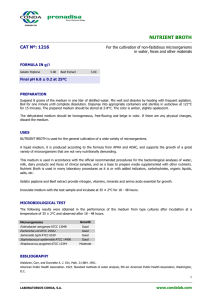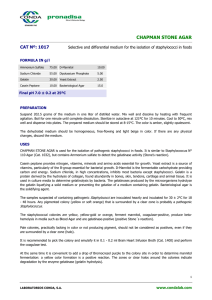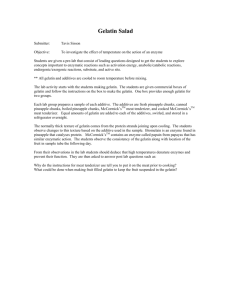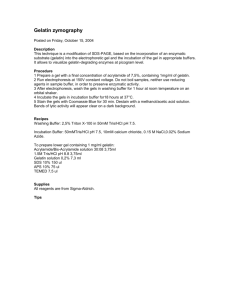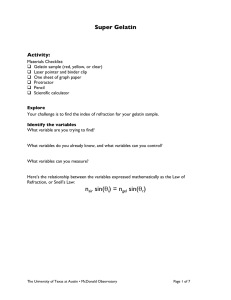NUTRIENT GELATIN CAT Nº: 1300 For testing proteolitic microorganisms that liquefy gelatin
advertisement
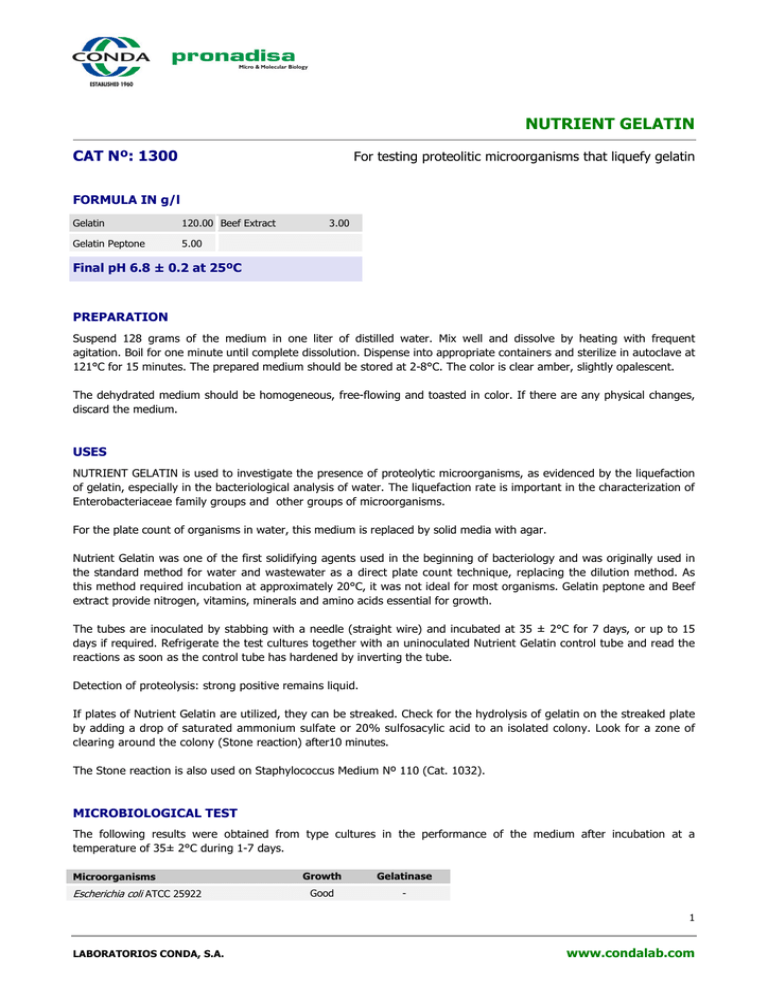
NUTRIENT GELATIN CAT Nº: 1300 For testing proteolitic microorganisms that liquefy gelatin FORMULA IN g/l Gelatin 120.00 Beef Extract Gelatin Peptone 5.00 3.00 Final pH 6.8 ± 0.2 at 25ºC PREPARATION Suspend 128 grams of the medium in one liter of distilled water. Mix well and dissolve by heating with frequent agitation. Boil for one minute until complete dissolution. Dispense into appropriate containers and sterilize in autoclave at 121°C for 15 minutes. The prepared medium should be stored at 2-8°C. The color is clear amber, slightly opalescent. The dehydrated medium should be homogeneous, free-flowing and toasted in color. If there are any physical changes, discard the medium. USES NUTRIENT GELATIN is used to investigate the presence of proteolytic microorganisms, as evidenced by the liquefaction of gelatin, especially in the bacteriological analysis of water. The liquefaction rate is important in the characterization of Enterobacteriaceae family groups and other groups of microorganisms. For the plate count of organisms in water, this medium is replaced by solid media with agar. Nutrient Gelatin was one of the first solidifying agents used in the beginning of bacteriology and was originally used in the standard method for water and wastewater as a direct plate count technique, replacing the dilution method. As this method required incubation at approximately 20°C, it was not ideal for most organisms. Gelatin peptone and Beef extract provide nitrogen, vitamins, minerals and amino acids essential for growth. The tubes are inoculated by stabbing with a needle (straight wire) and incubated at 35 ± 2°C for 7 days, or up to 15 days if required. Refrigerate the test cultures together with an uninoculated Nutrient Gelatin control tube and read the reactions as soon as the control tube has hardened by inverting the tube. Detection of proteolysis: strong positive remains liquid. If plates of Nutrient Gelatin are utilized, they can be streaked. Check for the hydrolysis of gelatin on the streaked plate by adding a drop of saturated ammonium sulfate or 20% sulfosacylic acid to an isolated colony. Look for a zone of clearing around the colony (Stone reaction) after10 minutes. The Stone reaction is also used on Staphylococcus Medium Nº 110 (Cat. 1032). MICROBIOLOGICAL TEST The following results were obtained from type cultures in the performance of the medium after incubation at a temperature of 35± 2°C during 1-7 days. Microorganisms Escherichia coli ATCC 25922 Growth Gelatinase Good 1 LABORATORIOS CONDA, S.A. www.condalab.com Staphylococcus aureus ATCC 25923 Good + BIBLIOGRAPHY Ewing Enterobacteriaceae USPHS Publication 734 Washington, 1960. Edwards and Ewing. Identification of Enterobacteriae, Burgess Publ. Co. Minneapolis, Minn., 1962. Standard Methods for the Examination of Water and Sewage, Ninth Edition APHA Inc. New York, 1960 STORAGE 25ºC Once opened keep powdered medium closed to avoid hydration. 2ºC 2 LABORATORIOS CONDA, S.A. www.condalab.com
